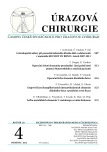Surgical Treatment of Distal Crural Fractures
Authors:
Pavel Kvasnička; Michal Mašek; Pavol Vojtaník
Authors‘ workplace:
Klinika Úrazové chirurgie LF MU a TC FN Brno
Published in:
Úraz chir. 20., 2012, č.4
Overview
PURPOSE:
The aim of this article is to evaluate patients data after distal tibia fracture treatment, to set up optimal algorithm of surgical therapy, and to optimize treatment strategy of injured patients.
MATERIAL AND METHODS:
Between 2008 and 2011 121 patients with distal tibia fracture were treated at the Department of Trauma Surgery, University Hospital Brno. The most common method used for the definitive treatment of distal tibia fractures was open reduction and internal fixation with LCP – locking compression plate (91 patients). Angle stable and anatomically preformed plates were used for the stabilization of distal tibia fractures. Seven fractures were stabilized by miniosteosynthesis using screws and wires. Eighteen out of 45 patients with extra-articular fractures of distal tibia were treated with intramedullary nail osteosynthesis.
RESULTS:
Detailed follow-up study included patients with intra-articular fractures of distal tibia (AO classification type B and C). Rate of wound complications and radiographic evaluation by Burwell and Charnley were assessed. Patient’s satisfaction and clinical findings were evaluated by AOFAS scoring system.
CONCLUSION:
This article informs about possibilities of surgical treatment of distal tibia fractures. It summarizes literature sources, evaluates the data of patients operated on at our department and proposes instructions how to treat these fractures. Therapeutic steps in current surgical treatment of distal tibia fractures have been clearly recommended and defined. Their maintenance significantly decreases the risk of postoperative complications. The treatment goals are anatomical reconstruction of the fracture and restoration of the injured limb function with early return of patient into the normal life activities. Due to bad results of conservative therapy, operative therapy of distal tibia fractures is preferred. Anatomically preformed plates enable to stabilize the fractures with MIPO (minimal invasive percutaneous osteosynthesis) technique. Surgical treatment of these fractures is demanding due to risk of severe complications.
KEY WORDS:
fractures of the distal tibia, plate osteosynthesis, soft tissue envelope.
Sources
1. BONE, L., STEGEMANN, P., MCNAMARA, et al, R. External Fixation of Severely Comminuted and Open Tibial Pilon Fractures. Clin. Orthop. 1993, 292,101-107.
2. BORENS, O., KLOEN, P., RICHMOND, J. Minimally Invasive Treatment of Pilon Fractures with a low Profile Plate: Preliminary Results in 17 cases. Arch Orthop Trauma Surg. 2009, 129, 649-659.
3. BOURNE, R. B. Pylon Fractures of the Distal Tiba. Clin Orthop. 1989, 240-42-46.
4. BURWELL, HN., CHARNLEY, AD. The Treatment of Displaced Fractures at the Ankle by Rigid Internal Fixation and early Joint Movement. J Bone Point Surg Br. 1965, 47, 634-660.
5. CASTELLANI, CH., RIEDL, G., EBERL, R., et al, Transitional Fractures of the Distal Tibia: A Minimal Access Approach for Osteosynthesis. J Trauma. 2009, 67, 1371-1375.
6. COLLINGE, C., PROTZMAN, R. Outcomes of Minimally Invasive Plate Osteosynthesis for Metaphyseal Distal Tibia Fractures. J Orthop Trauma. 2010, 24 24-29.
7. COURT – BROWN, C.M., Mc BIRNE, J. The Epidemiology of Tibial Fractures. J Bone Point Surg. 1995, 3, 417-421.
8. DRÁČ, P. Ovlivňuje stabilizace fibuly výsledky léčby zlomenin distální třetiny dialýzy tibie? Úraz Chir. 2005, 13, 39-44.
9. EVANS, J.M., GARDNER, M.J., BRENNAN, M.L., et al, Intramedullary Fixation of Fibular Fractures Associated With Pilon Fractures. J Orthop Trauma. 2010, 24, 491-494.
10. HOENIG, M., GAO, F., KINDER, J., et al, Extra-Articular Distal Tibia Fractures: A Mechanical Evaluation of 4 Different Treatment Methods. J Orthop Trauma. 2010, 24, 30-35.
11. HOPPENFELD, S., DeBOER, P., BUCKLEY, R. The Anatomic Approach. Philadelphia: Lippincott Williams. 2009, 585-652.
12. IMADE, S., TAKAO, M., NISHI, H., UCHIO, Y. Arthroscopy-Assisted Reduction and Percutaneous Fixation for Triplane Fracture of the Distal Tiba. Arthroscopic Surg. 2004, 20, 123-128.
13. KONDA, S.R., JORDAN, CH.J., et al, A Novel Technique for Reduction and Immobilization of Tibial Shaft Fractures: The Hammock. J Orthop Trauma. 2011, 25, 385-390.
14. MEHTA, S., GARDNER, M.J., BAREI, D.P., et al, Reduction Strategies Through the Anterolateral Exposure for Fixation of Type B and C Pilon Fractures. J Orthop Trauma. 2011, 25, 116-122.
15. PURNELL, G.J., GLASS, E.R., ALTMAN, D.T., et al, Results of a Computed Tomography Protocol Evaluating Distal Third Tibial Shift Fractures to asess Noncontiguous Malleolar Fractures. Trauma Inj. 2011, 71, 163-167.
16. RISTINIEMI, J., LUUKINEN, P., OHTONEN, P. Surgical Treatment of Extra-Articular or Simple Intra-Articular Distal Tibial Fractures: External Fixation versus Intramedullary Nailing. J Orthop Trauma. 2011, 25, 101-105.
17. RUOFF, AC. Snider, RK., Explosion Fractures of the Distal Tibia with Major Articular Involvement. J Trauma. 1971, 11, 866-873.
18. RÜEDI, T., MURPHY, W.M. AO Principles of Fracture Management. Stuttgart-New York: Thieme. 2000, 888.
19. RÜEDI, T., ALLGÖVER, M. The Operative Treatment of Intra-articular Fractures of the Tibia into Ankle Joint. Injury. 1969, 1, 92-99.
20. TEENY, S. M., WISS, D. A. Open Reduction and Internal Fixation of Tibial Plafond Fractures. Clin. Orthop. 1993, 292, 108-117.
21. VALLIER, H.A., CURETON, B.A., PATTERSON, B.M. Randomized, Prospective Comparsion of Plate versus Intramedullary Nail Fixation for Distal Tibia Shaft Fractures. J Orthop Trauma. 2011, 0, 1-5,
Labels
Surgery Traumatology Trauma surgeryArticle was published in
Trauma Surgery

2012 Issue 4
Most read in this issue
- The treatment of unstable fractures of fifth metacarpal bone by external fixator
- Surgical Treatment of Distal Crural Fractures
- The surgical treatmant of the proximal humerus fractures with Humerusblok in elderly
- Two-stage operative treatment of complicated distal tibia intraarticular fractures using external fixator
